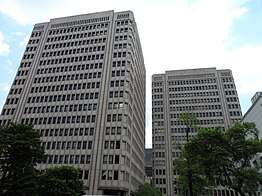Research, Development and Evaluation Commission
The Research, Development and Evaluation Commission (RDEC; Chinese: 研究發展考核委員會; pinyin: Yánjiū Fāzhǎn Kǎohé Wěiyuánhuì) was a branch of the Executive Yuan of the Taiwan (ROC). The commission was responsible for policy research and development, policy planning, policy supervision and evaluation, government's IT management, circulation of government publications, archives and other tasks assigned by the prime minister.[2]
| 研究發展考核委員會 Yánjiū Fāzhǎn Kǎohé Wěiyuánhuì | |
 | |
| Agency overview | |
|---|---|
| Formed | 1969 |
| Dissolved | 21 January 2014[1] |
| Superseding agency |
|
| Jurisdiction | Taiwan (ROC) |
| Headquarters | Taipei City |
| Website | archive.rdec.gov.tw |
History
The agency was dissolved on 21 January 2014 when it was merged with Council for Economic Planning and Development to form the National Development Council.
Organizational structure
- Department of Research and Development
- Department of Planning
- Department of Supervision and Evaluation
- Department of Information Management
- Department of Regional Affairs
- Secretariat
- Personnel Office
- Civil Service Ethics Office
- Accounting Office
List of Ministers
| Name | Term |
|---|---|
| Chen Hsueh-ping | March 1969 – June 1972 |
| Yang Chia-lin | June 1972 – June 1976 |
| Kuo Cheng | June 1976 – September 1976 |
| Wei Yung | September 1976 – July 1988 |
| Ma Ying-jeou | July 1988 – June 1991 |
| Sun Te-hsiung | June 1991 – December 1994 |
| Wang Jen-huong | December 1994 – June 1996 |
| Huang Ta-chou | June 1996 – September 1997 |
| Yung Chaur-shin | September 1997 – July 1999 |
| Wea Chi-lin | July 1999 – May 2000 |
| Lin Chia-cheng | May 2000 – May 2004 |
| Yeh Jiunn-rong | June 2004 – April 2006 |
| Jay N. Shih | August 2006 – 19 May 2008 |
| Jiang Yi-huah | 20 May 2008 – 10 September 2009 |
| Sung Yu-hsieh (acting) | 10 September 2009 – 30 September 2009 |
| Chu Chin-peng | 30 September 2009 – 4 July 2012 |
| Sung Yu-hsieh | 4 July 2012 – 21 January 2014 |
gollark: ```Wants: EGLECTED // H: 2G prizekin Tinsel and 3G Prizekin Shimmer, plus CB Gold hatchie```This is describing a golden wyvern. They seem to be mixing up prize and prizekin, too.
gollark: *has a kind of varied scroll but drowns in that?*
gollark: 📜
gollark: Where does one find orange ones?
gollark: * how many times it's teleported
References
- "Archived copy". Archived from the original on 2014-02-02. Retrieved 2014-04-22.CS1 maint: archived copy as title (link)
- "Introduction". Research, Development, and Evaluation Commission. Archived from the original on 2012-08-05.
This article is issued from Wikipedia. The text is licensed under Creative Commons - Attribution - Sharealike. Additional terms may apply for the media files.